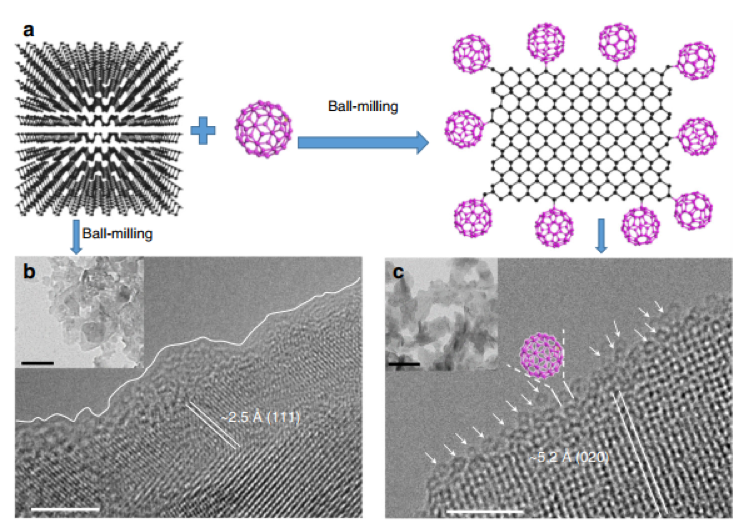On October 9th, the world-renowned academic journal Nature Communications published the research results of the new application of Fullerene C60 led by YANG Shangfeng, Professor of the University of Science and Technology of China (USTC). Researchers showed that edge-selective functionalization of black phosphorus nanosheets by covalently bonding stable C60 molecules leads to its significant stability improvement.

Microstructural characterizations,Image by YANG Shangfeng
As a new 2D material, Few-layer black phosphorus (BP) has been attracting increasing interest owing to its unique band structure featuring direct band gap with thickness-dependent gap energy and high charge carrier mobility, thus rendering potential applications in transistors, biomedicine, energy conversion, and storage. However, it’s easily oxidized under ambient condition, which severely restricts its applications. Thus, improving the ambient stability of BP is a prerequisite for its practical applications.
In view of the fact that Fullerene C60 owns high stability against light, oxygen and water, YANG’s team successfully synthesized BP- C60 hybrid based on solid-state mechanochemical method, which was developed in their previous research (Adv. Mater. 2017, 29, 1605776). In collaboration with Prof. JI Hengxing, Prof. DU Pingwu, and Prof. LU Yalin of School of Chemistry and Material science, USTC, and with Prof. YAN Wensheng and Prof. WEI Shiqiang of National Synchrotron Radiation Lab., YANG’s team conducted a series of morphological and spectroscopic characterizations of BP- C60 hybrid, confirming the successful edge-selective bonding of C60 within BP- C60 hybrid. C60 molecules bonding at the edges of BP nanosheets serve as sacrificial shield, resulting in significant stability improvement of BP nanosheets against oxidation as well as obviously enhanced photoelectrochemical and photocatalytic activities of BP.
The research not only paves the way towards ambient processing and applications of BP, but also yield new insight into developing further applications of Fullerenes.
ZHU Xianjun, doctoral student who just graduated from School of Chemistry and Material science, USTC, is the first author of the research article. Prof. YANG Shangfeng is the only corresponding author. This work was partially supported by the National Key Research and Development Program of China, National Natural Science Foundation of China, the Major/Innovative Program of Development Foundation of Hefei Center for Physical Science and Technology, and the Fundamental Research Funds for the Central Universities.
These years, YANG’s team has been committed to develop new Fullerene/2D nanomaterial hybrids to expand the applications of Fullerenes. YANG’s team was also invited by Wiley, Germany to write a review article, published with the title “Hybrids of Fullerenes and Two-Dimensional Nanomaterials”. (Adv. Sci.2018, DOI: 10.1002/advs.201800941)
Read full article:https://www.nature.com/articles/s41467-018-06437-1.
(Written by QIANG Jiaxuan, edited by YE Zhenzhen, USTC News Center)